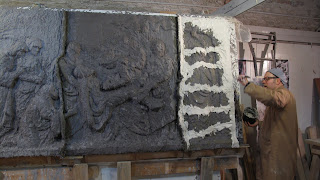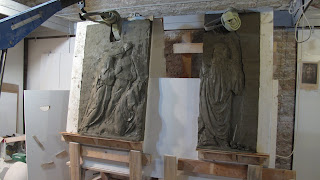 The first panel is set up next to the plaster model after the initial roughing out of the stone.
The first panel is set up next to the plaster model after the initial roughing out of the stone.This blog records the processes involved in the creation of a marble sculpture.
Saturday, March 26, 2011
Thursday, March 24, 2011
Wednesday, March 23, 2011
Tuesday, March 22, 2011
making the waste mold
Monday, March 21, 2011
Relief for a chapel in Backnang, Germany
 In October of last year I received notice that an organization in Backnang, Germany was interested in creating a relief sculpture in marble. An original sculpture had been lost many years ago and someone found a picture of this in the archives of the chapel that held the sculpture. I was asked to use the original image and create a sculpture. This sculpture was created by an artist name Schnabel around 1884.
In October of last year I received notice that an organization in Backnang, Germany was interested in creating a relief sculpture in marble. An original sculpture had been lost many years ago and someone found a picture of this in the archives of the chapel that held the sculpture. I was asked to use the original image and create a sculpture. This sculpture was created by an artist name Schnabel around 1884.This blog is a record of the different processes involved in the creation of this artwork.
Here you see the black and white image enlarged to the desired size.
Subscribe to:
Posts (Atom)

















